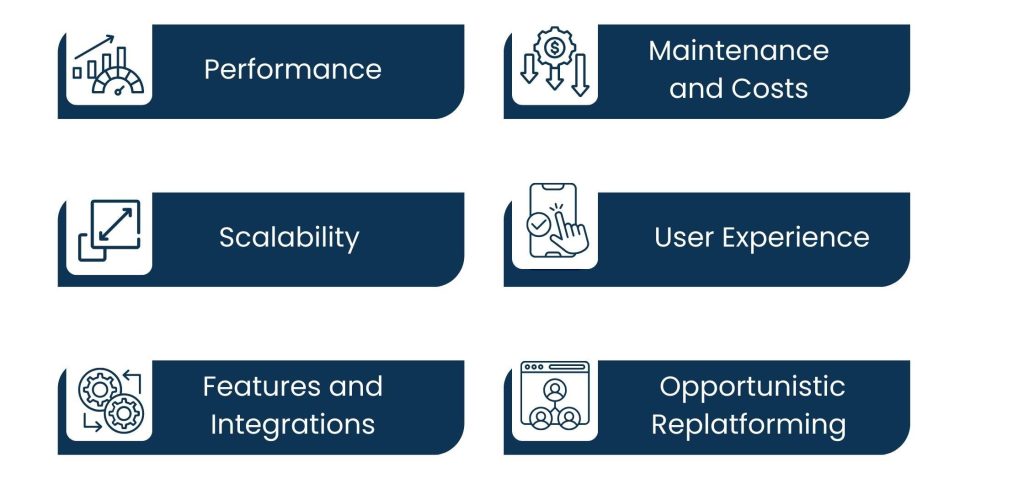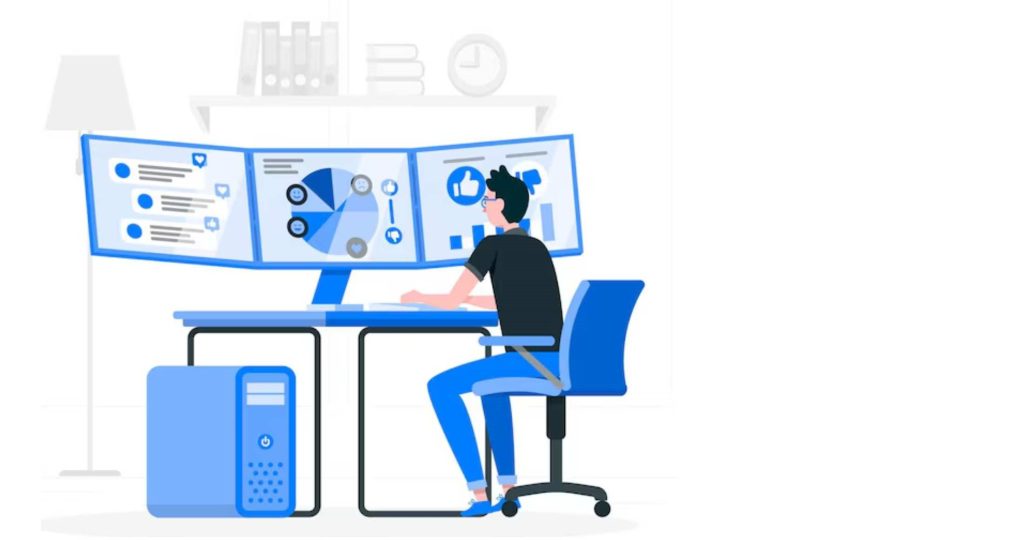Introduction
Ecommerce replatforming is a critical transition for any e-commerce business. E-commerce moves fast, and so must your technology. As businesses grow, customer demands increase, and market dynamics shift, the tools that once worked can start holding you back. Eventually, most online retailers reach a point where their current platform no longer supports their goals, whether it’s because of slow performance, high costs, limited customization, or poor scalability. That’s when ecommerce replatforming becomes necessary.
If not handled properly, it can lead to prolonged downtime, broken customer experiences, and significant revenue loss. These risks often make businesses hesitant to leap, even when they know it’s time. The good news? Downtime is avoidable with careful planning, strong collaboration, and proven strategies. Whether you’re migrating to improve site speed, streamline operations, or prepare for growth, the key is to treat replatforming not just as a technical project, but as a business-critical initiative.
Here’s what experienced professionals recommend to ensure your e-commerce platform process goes as smoothly as possible!
Why Businesses Replatform
Ecommerce businesses aren’t in the business of replatforming for fun. They do it because they must. As the expectations of even the most comfortable customers rise and technology continues to develop, platforms that a successfully powered today can put a damper on growth.
What once served as a good solution may now be holding you back. If your site is slow, hard to maintain, or cost-prohibitive to house, that’s not just a technical problem; it’s a competitive liability.

1. Performance
Today, customers would expect a two-second or less loading time. Every delay could result in abandoned carts, a decreased search rank a damaged brand reputation. During promotion peaks – like Black Friday or during a flash sale – if the site is slow, that can result in thousands of dollars in lost revenue”. Ecommerce replatforming is also an opportunity to replace it with a system designed for speed and the modern demands of traffic.
2. Scalability
As businesses scale, they introduce new products, market to global units, or increase their sales channels. An e-commerce store that worked great for you previously may now be falling short. If you cannot scale from that standing start and do so relatively quickly, then the business is likely to slowly die.
3. Features and Integrations
You might need features like advanced customization, machine learning-driven recommendations, or deep integrations with marketing automation systems, CRMs, or ERP systems. If you can’t do all that on your current system, then this limits innovation and competitiveness.
4. Maintenance and Costs
Older platforms might not even have automatic updates, or custom coding patches, or development you need in place to get back up and running. These disguised costs amass very rapidly and represent a continual drain on resources. Ecommerce replatforming can also cut long-term costs by eliminating technical debt.
5. User Experience
Our shopper of today wants sleek, mobile-optimized, easy shopping experiences. What goes on behind the scenes, the back office of your team is an admin panel that’s easy for non-technical users, orders, products, and deals. If your product annoys either of them, it’s impeding your growth.
6. Opportunistic Ecommerce replatforming
Sometimes, Ecommerce replatforming isn’t about solving pain points, but future-proofing your business. Your existing system may appear to function adequately, but it’s ironically not helping you scale faster, sell more, or serve your customers more effectively. A new platform may provide a set of opportunities you never knew you were lacking.
The only valid reason companies replatform is for the company to move forward.” A good Ecommerce replatforming delivers a system that is faster, more flexible, and more closely aligned with your objectives. Whether problems-driven or vision-driven, the result should be a more flexible, competitive, and profitable e-commerce operation.
Whatever the motivation, the intended result is the same for most: a better-performing, more scalable, and more profitable ecommerce operation.
Also Read: Virtual Assistant Services in Barka
Down Time Is a Real Risk
Just a few minutes of downtime can cost e-commerce brands thousands of dollars. Every instance that your website is down and prospects are bouncing, interrupts leads, and damages your reputation. Combine this with longer-term positions in SEO rankings, decreased trust, and compromised customer retention, and the stakes are too high.
That’s why a fast time to market as part of a replatforming project is not just a nice-to-have – it is a must.

Here is only a partial list of common migration headaches that can cause downtime:
- Data migration problems: Bad planning, format mismatches, corrupt records, these can all cause your cornerstone systems to fall apart and speed suddenly plummet.
- DNS misconfiguration: This one involves faulty DNS propagation settings during the switch over, which can cause your website to go off the grid temporarily.
- New platform bugs: If you roll out untested code or poorly-integrated plugin releases your new platform could tank your site.
- Bad testing or rollout planning: Skipping quality assurance or rolling out all at once without fallback plans is a widespread and expensive error.
- Poor payment/shipping system integrations: If these sites’core functions are off the rails, the website might seem fine but visitors won’t be able to make purchases.
In addition to technical factors, communication issues and clashing timelines may exacerbate the situation. If your customer support teams are nowhere near ready, or if marketing launches are struggling with Ecommerce replatforming efforts, you create organizational chaos. And it’s not just the moment the site goes down.
The effects can linger. Customers who experienced service errors or delays during their visit have not returned. A dip in Google rankings due to accessibility problems can take months to get back. In other words, every time someone is denied access to your store, your brand’s credibility takes a hit. The solution? Planning and multiple department collaboration.
Early understanding of the risks means you can mitigate them with backup plans, clear reporting lines, and staged rollouts. Testing is not a choice but a necessity. And development, marketing, operations, and support must communicate well. But at the end of the day, downtime isn’t inevitable. Strategic planning, vigorous testing, and the right people will ensure that your ecommerce replatform is seamless and goes unnoticed by your customers.
Pro Tricks to Avoid Downtime While Ecommerce Replatforming

1. Establish Clear Objectives
Your reason for replatforming and have a clear picture of success. This is a great way to prioritize features, timeline, and budget. What the authors mean here is that goals can provide clarity to the boundary lines of a project and keep the team focused. They provide a measure of post-launch success as well.
2. Pick the Right Platform for Ecommerce Replatforming
Pick a platform that aligns with your growth goals, tech stack, and operational needs. Find one with a reputation for high uptime and solid support. Assess how your platform can scale, sustain high-end traffic, and work with your existing systems.
3. Construct a Transition Team
Include project managers, developers, marketers, and customer service reps. Each team has a unique ability to spot a type of risk that others won’t. Having a cross-functional team ensures that the technical and customer impacts are both considered as part of the planning process.
4. Map and Audit All Data
Before migrating, clean up your database. Make sure everything is mapped correctly. Bad data is one of the top reasons post-launch problems blossom. Check out the database structures and unify their formats for the transfer with no issues.
5. Test Everything (Then Test Again)
Test in multiple rounds: staging site, integrations, load times, checkout process, mobile UX. You’re going to need to stress-test the system to see how it reacts to a real-life type of situation. Factor in user testing and stress testing before rolling the new platform out to make sure it meets your peak demand.
6. Try a Soft Launch or Rollout Plan
Rather than fully implementing all your changes at once, launch them slowly. Begin with a small audience or region and expand once the surviving transfer is established. Such a measured approach mitigates risk and enables a feedback loop before the implementation goes into full production.
7. Plan to Rollback
Have a rollback plan. You need to be able to roll quickly back to the old platform in case something breaks. Keep your backups, rollback scripts, and unplanned processes ready to run.
8. Keep Everyone in the Loop
Let customers know clearly. Inform them of changes on the horizon and assure them that you’re working to make things better. Transparency builds trust. Internally, ensure your teams have been briefed and have the resources they need to respond to enquiries during the change.
Pre- Ecommerce Replatforming Checklist
Before beginning an ecommerce replatforming project, it’s all about preparation. A bad start, such as one that is rushed or unclear, will invariably result in mess-ups later. This checklist provides a framework to ensure that project managers and leadership are aligned, there are no surprises, and everyone is on the same page.

- Articulate clear business goals: Understand why you’re replatforming. It is due to better performance, scalable, UX improvements or better integration?
- Evaluate current shortcomings of the platform: Determine what the bottlenecks, bugs, and pain points are for your current system.
- Pick the right platform: Select vendors, demo offerings, and map functionality to your short- and long-term business needs.
- Form a cross-functional team: Assign roles among IT, marketing, operations, and customer support.
- Do a content audit: Review all product pages, images, SEO metadata, and URLs to make sure that there will be no loss of vital materials.
- Audit integrations: Document what third-party tools (CRMs, ERPs, payment processors) exist, and what connections they’ll need to make to work with the new system.
- Develop a thorough timeline: Do not forget to consider milestones, test time frames, deployment dates, and rollback points.
- Customer communications: Plan for how you’ll communicate the upgrade to customers in a way that will create confidence and transparency.
Having completed this checklist, however, will significantly diminish both the chances of future downtime and the incidence of post-launch surprises.
Also Read: Virtual Assistant Services in Ibri
Post- Ecommerce Replatforming Monitoring and Optimization
After your shiny new ecommerce platform is live, it doesn’t mean your job is done. The first thirty days post-deployment are vital to help detect problems as early as possible and tweak bomb-proof performance.

Here’s what to watch and tweak:
- 404 errors and broken links: Use platform tools to crawl your site to check internal links, images, and redirect paths.
- Payment and checkout flows: Verify that every phase of the purchasing experience is as frictionless as possible. Test in several browsers and devices.
- Page load times: Use a ready-made audit tool, such as Google Page Speed Insights or GTmetrix, on-site performance tracker. Velocity affects both SEO and conversions.
- Traffic and bounce rates: Compare against pre-launch benchmarks to determine whether visitors are coming and converting as anticipated.
- Search visibility and indexing: Review the pages of your site or blog (URL in point 5) that are indexed and that you don’t have crawl errors in Google Search Console.
- Customer feedback: get users to share their complaints and experiences. Support tickets often uncover hidden problems.
- Operational processes: Order processing, inventory syncing, and reporting tools are fully functional and accurate. Post-launch optimization is not about trying to fix everything at once, it’s about identifying high-impact problems quickly and iterating.
SEO Considerations for Ecommerce Replatforming
Replatforming can have damaging effects on your SEO if done improperly.

These are key SEO activities to safeguard and maintain the ranks during the change:
- Preserve URL structure: Do your best to retain your URLs as they are. If changes are required, then simply 301s the old pages so you can conserve the link equity.
- Make a redirect map: Compile a list of every URL on the current site and where it should point to the new site.
- Update sitemaps and robots. txt: Submit the new XML sitemaps to Google Search Console and ensure that bots can crawl your new site.
- Retain metadata: Make sure all title tags, meta descriptions, alt text, and structured data are brought across accurately.
- Pay attention to indexing post-launch: Keep an eye on crawl stats and indexing rates in the weeks after launch. Recognize and troubleshoot problems with ease.
- Maintain internal links: Don’t forget to keep internal navigation and anchor links intact and useful for the user.
Optimising your website for search ensures you don’t lose that visibility when you make the move, and could even help improve it.
Conclusion: Ecommerce Replatforming Without Regret
Ecommerce replatforming should not be a traumatic experience. With smart planning, the right platform, and transparent collaboration across the departments, your business can upgrade without unnecessary downtime. This should feel like a natural transition for your customers and a sense of empowerment for your team.
Preventing downtime isn’t just about saving short-term revenue, it’s about preserving brand trust, retention of SEO rankings, and ensuring a smooth customer experience during a significant change. From selecting the platform to testing the migration, every choice contributes to the long-term success.
If you treat replatforming as a strategic initiative rather than a technical chore, you position your business for sustainable growth and innovation. With these pro tips and a strong execution plan, you can make the move with confidence and clarity, laying the foundation for a stronger, more scalable e-commerce future.
At Tasks Expert, our experienced professionals specialize in guiding ecommerce businesses through smooth, strategic replatforming. If you’re ready to minimize downtime and scale confidently, connect with us today.
About Us
Tasks Expert offers top-tier virtual assistant services from highly skilled professionals based in India. Our VAs handle a wide range of tasks, from part time personal assistant to specialized services like remote it support services, professional bookkeeping service etc. Furthermore, it helps businesses worldwide streamline operations and boost productivity.
Ready to elevate your business? Book a Call and let Tasks Expert take care of the rest.









